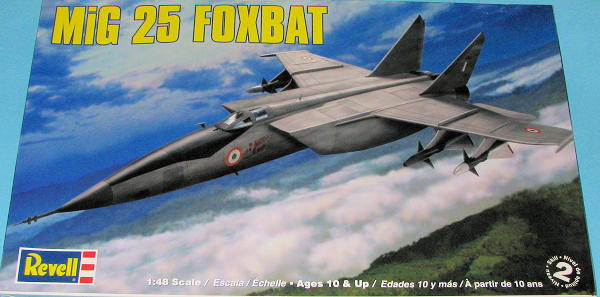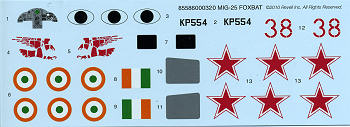
Revell 1/48 MiG-25 Foxbat
| KIT #: | 85-5860 |
| PRICE: | $20.95 MSRP |
| DECALS: | Two options |
| REVIEWER: | Scott Van Aken |
| NOTES: | Re-issue. Original mold dated 1978 |

| HISTORY |
The Mikoyan-Gurevich MiG-25 (Russian: МиГ-25) (NATO reporting name: Foxbat) is a high-supersonic interceptor and reconnaissance-bomber aircraft designed by the Soviet Union's Mikoyan-Gurevich bureau. First flown as a prototype in 1964, it entered service in 1970. With a top speed of Mach 2.83+, a powerful radar and four air-to-air missiles, the MiG-25 worried Western observers and prompted development of the F-15 Eagle in late 1960s. The aircraft's capabilities were better understood in 1976 when Soviet pilot Viktor Belenko defected in a MiG-25 to the United States via Japan. The MiG-25 series had a production run of 1,190 aircraft. The MiG-25 flew with a number of Soviet allies and former Soviet republics and it remains in limited service in Russia and several other nations.
An interesting aspect of the MiG-25 was that it had little in the way of exotic materials, using stainless steel in those areas the would gather the most heat. Even its radar, though very powerful, was vacuum tube technology instead of the transistorized and integrated circuits used by Western aircraft. Even the hydraulic fluid was little more than pure grain alcohol and in Belenko's book MiG Pilot, he comments on the ground crews often draining fluid from the aircraft to mix in drinks.
| THE KIT |
 This is another oldie that has not been reissued in probably decades and prior to this re-issue was commanding pretty high prices. Those who have built this comment that it is not a very good fitting kit, but aside from the Lindberg offering, is the only real option for those wanting this aircraft in 1/48 scale. Despite its 1978 heritage (which means raised panel lines), the molds have held up well. There is a lot of flash on the sprues, but the parts are relatively free of flash. They are not, however, free of ejector pin marks and you'll find them on many pieces, including the weapons pylons and inside gear doors. Some are quite deep and will require filling while others can simply be sanded or scraped down. Even the instrument panel has them. However, the panel will be covered by a decal so only needs to have them filled in and painted.
This is another oldie that has not been reissued in probably decades and prior to this re-issue was commanding pretty high prices. Those who have built this comment that it is not a very good fitting kit, but aside from the Lindberg offering, is the only real option for those wanting this aircraft in 1/48 scale. Despite its 1978 heritage (which means raised panel lines), the molds have held up well. There is a lot of flash on the sprues, but the parts are relatively free of flash. They are not, however, free of ejector pin marks and you'll find them on many pieces, including the weapons pylons and inside gear doors. Some are quite deep and will require filling while others can simply be sanded or scraped down. Even the instrument panel has them. However, the panel will be covered by a decal so only needs to have them filled in and painted.
Speaking of the cockpit, there is a control stick and rather generic looking seat with belts molded on for this are. There is no sidewall detail. The fuselage has the rear section molded horizontally, while the nose is vertical. Frankly, though this is boxed as a recce bird, I have the feeling that the nose cone is too large and more appropriate for the interceptor version. MiG-25 fans can correct me if I'm mistaken on this. There are separate intakes with intake duct control vanes blocking any compressor views. The twin tails and wings are molded in halves so there will be areas there to be sure to be properly mated. I'm sure the trailing edges will be too thick.
Landing gear look to be well done as the MiG-25 was designed to operate on unimproved runways. The kit can be built with gear up, however, there is no stand and anyway, it will be a very big model so perhaps too large for a stand. The four missiles are such that the one pair of fins slots into the two body halves before the halves are cemented together. It is sure to require considerable clean-up and really, I'm not sure a recce bird would have these or their pylons as speed is paramount. The canopy can be posed open or closed. It is nicely molded, but unless you plan on a better cockpit, best to keep it closed. I imagine the fit to be rather iffy as it certainly was on the MiG-21, a kit of similar vintage.
 Instructions are well done with paint info in generic and FS 595 references. Each of the 14 construction steps are well drawn and provide both part name an
Instructions are well done with paint info in generic and FS 595 references. Each of the 14 construction steps are well drawn and provide both part name an d any color info. There are two markings options. One is the box art plane, a MiG-25RB of 102 squadron, Indian Air Force in 1985. It is overall light gull grey. The second option is a camouflaged Soviet MiG-25 RBK based at Brandenburg, Germany in 1990. It is light gull grey on the underside with patches of field green, sand and dark tan on the upper and side surfaces. The decals are well printed and I found the similar ones on the MiG-21 to go on without any trouble. Decals are used for the camera ports and side nose radomes.
d any color info. There are two markings options. One is the box art plane, a MiG-25RB of 102 squadron, Indian Air Force in 1985. It is overall light gull grey. The second option is a camouflaged Soviet MiG-25 RBK based at Brandenburg, Germany in 1990. It is light gull grey on the underside with patches of field green, sand and dark tan on the upper and side surfaces. The decals are well printed and I found the similar ones on the MiG-21 to go on without any trouble. Decals are used for the camera ports and side nose radomes.
As a final note, Revell has taken to adding a large cardboard stiffener to those kits in the somewhat flimsy boxes they now use. I appreciate that as it keeps the box and contents from being squished when stacked.
| CONCLUSIONS |
Ok, not new, not particularly well detailed, but a great place to start if you want to do the extra work. Best of all, it is at a good price for what will be a quite large model when you are done.
| REFERENCES |
http://en.wikipedia.org/wiki/MiG-25 June 2010 Thanks to me for this one. If you would like your product reviewed fairly and fairly quickly, please contact the editor or see other details in the